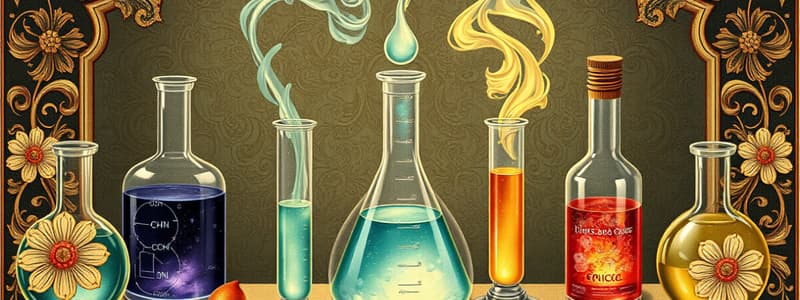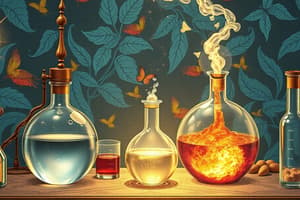Podcast
Questions and Answers
What does the Law of Conservation state?
What does the Law of Conservation state?
- Only certain elements can form compounds
- Matter and mass cannot be created or destroyed in chemical reactions (correct)
- Atoms can be created or destroyed in chemical reactions
- Mass ratios of the elements in compounds can change
What is the Law of Definite Proportions?
What is the Law of Definite Proportions?
Mass ratios of the elements that make up a given compound are always the same.
What does the Law of Multiple Proportions state?
What does the Law of Multiple Proportions state?
Only whole numbers can be used to combine elements to form compounds.
What is an atom?
What is an atom?
What are the two regions that make up all atoms?
What are the two regions that make up all atoms?
The properties of electrons made by Thomson & Millikan are: 1. Present in all atoms and elements, 2. Mass and charge never change, 3. Electrons have a large _____ to mass ratio, 4. Electrons have a mass of 9.109 x 10 -31 kg.
The properties of electrons made by Thomson & Millikan are: 1. Present in all atoms and elements, 2. Mass and charge never change, 3. Electrons have a large _____ to mass ratio, 4. Electrons have a mass of 9.109 x 10 -31 kg.
How can Rutherford's model of the atom be summarized?
How can Rutherford's model of the atom be summarized?
What number uniquely identifies an element?
What number uniquely identifies an element?
What are isotopes?
What are isotopes?
How are isotopes alike?
How are isotopes alike?
How are isotopes different?
How are isotopes different?
What is the atomic number of an element?
What is the atomic number of an element?
What is the mass number of an isotope?
What is the mass number of an isotope?
What is a mole?
What is a mole?
What is the abbreviation for mole?
What is the abbreviation for mole?
How many particles are in one mole?
How many particles are in one mole?
What is the name given to the number of particles in a mole?
What is the name given to the number of particles in a mole?
What is the molar mass of an element?
What is the molar mass of an element?
How is the mass in grams of the element converted to the amount in moles?
How is the mass in grams of the element converted to the amount in moles?
How is the mass in grams of the element converted to the number of atoms?
How is the mass in grams of the element converted to the number of atoms?
What is the nucleus of an atom?
What is the nucleus of an atom?
Who discovered the atomic nucleus?
Who discovered the atomic nucleus?
What are the two kinds of particles that make up the nucleus?
What are the two kinds of particles that make up the nucleus?
What are two compounds that demonstrate the Law of Multiple Proportions?
What are two compounds that demonstrate the Law of Multiple Proportions?
How do you convert moles to grams?
How do you convert moles to grams?
How do you convert grams to moles?
How do you convert grams to moles?
How do you convert moles to atoms?
How do you convert moles to atoms?
How do you convert grams to atoms?
How do you convert grams to atoms?
Study Notes
Key Laws in Chemistry
- Law of Conservation: Matter and mass cannot be created or destroyed in chemical reactions.
- Law of Definite Proportions: Elements in a compound exist in fixed mass ratios regardless of the amount or method of formation.
- Law of Multiple Proportions: Compounds are formed from elements in whole number ratios.
Atomic Structure
- Atom: The smallest particle of an element retaining its chemical properties.
- Regions of Atoms: Comprised of a nucleus (center with protons and neutrons) and electrons (surrounding the nucleus).
Electron Properties
- Present in all atoms and elements.
- Have consistent mass and charge.
- Possess a high charge-to-mass ratio.
- Mass of an electron is approximately 9.109 x 10^-31 kg.
Rutherford's Atomic Model
- Discovered positive charge in the center due to electrons bouncing back during gold foil experiment.
Atomic Identity
- Atomic Number: Unique number identifying an element, equal to the number of protons.
- Isotopes: Variants of the same element with different masses due to differing neutron numbers.
- Isotopes share the same atomic number but differ in neutron count.
Mass and Moles
- Mass Number: Total of protons and neutrons in an isotope's nucleus.
- Mole: Quantity containing the same number of particles as atoms in 12g of carbon-12, defined as 'mol'.
- Avogadro's Number: The number of particles in one mole, approximately 6.022 x 10^23.
Molar Mass
- Equal numerically to the atomic mass and expressed in g/mol.
- Conversion between grams and moles and vice versa requires formulas based on molar mass.
Conversion Formulas
- Moles to grams: Multiply moles by molar mass.
- Grams to moles: Divide grams by molar mass.
- Moles to atoms: Multiply moles by Avogadro's number.
- Grams to atoms: Convert grams to moles and then to atoms using Avogadro's number.
Structure of the Nucleus
- Comprised of protons and neutrons, discovered by Rutherford.
Examples of Chemical Compounds
- Demonstrating Law of Multiple Proportions: Carbon dioxide (CO2) and carbon monoxide (CO).
Additional Notes
- Maintain clarity in unit conversion steps to avoid mistakes in calculations.
Studying That Suits You
Use AI to generate personalized quizzes and flashcards to suit your learning preferences.
Description
Revise key concepts from Chemistry Chapter 3 with these flashcards. Each card presents essential laws that govern chemical reactions, including the conservation of mass and the proportions of compounds. Perfect for quick review and reinforcement of foundational chemistry principles.




